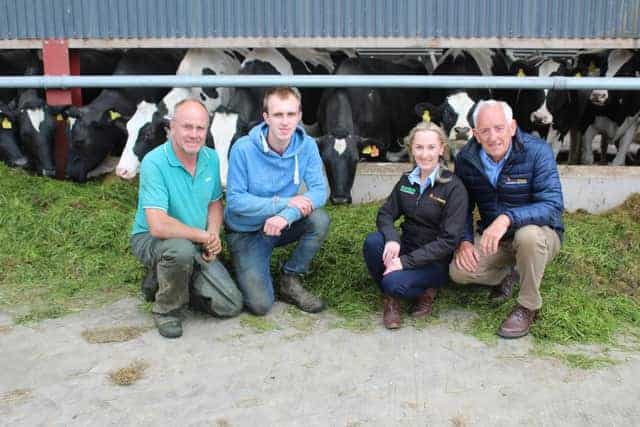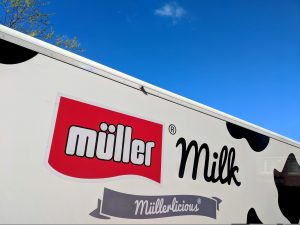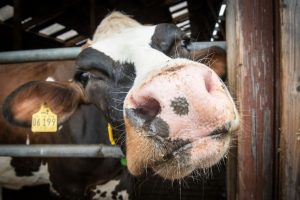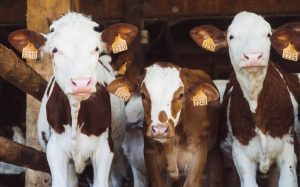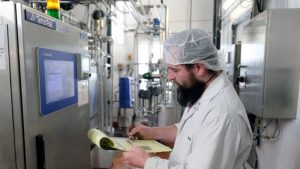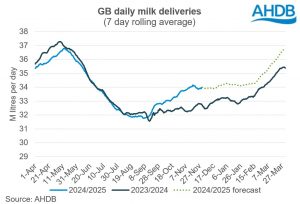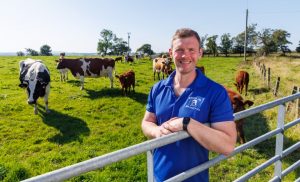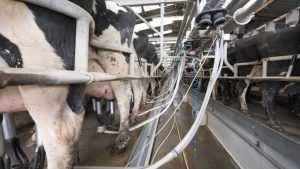
While base prices are obviously important, it is the bonuses that dairy farmers can secure through improvements in milk quality that are delivering an added level of sustainability security to the sector, writes Richard Halleron.
This is particularly so in a region such as Northern Ireland, where improved levels of components (butterfat and protein) add real value to the milk that is processed into cheese, butter and the growing number of value-added dairy products now available.
The role that improved dairy cow nutrition plays in making this happen cannot be under estimated.
And it’s all about feeding the rumen.
By virtue of this fact alone, high quality forages – grazed grass and silage – will always drive cow performance.
But given the vagaries of our climate, these forages will always be very variable in terms of their quality.
The last week or so has seen the return of the rains to Northern Ireland.
But the month and half prior to this were characterised by unseasonably dry, hot conditions.
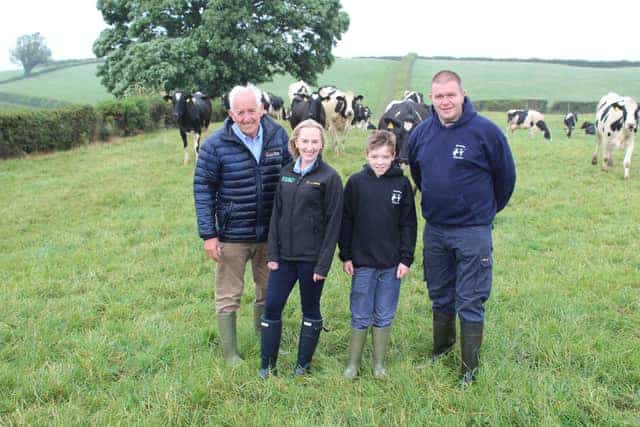
The result of this was an absolute slow-down in grass growth.
And, of course, the same, weather-related challenges confronted livestock farmers during the summer of 2022.
Variations in weather can also impact on silage quality, irrespective of what steps the farmer or contractor takes during the ensiling process.
And then, of course, there are the totally invisible factors that come into play when it comes to determining conserved forage quality – the threat of mycotoxins being a case in point.
The good news is that the inclusion of high quality concentrates can be used to balance out and add to the overall nutritional value of diets fed to dairy cows.
The appliance of science
It’s all about the appliance of science and new technology, an aspect of ruminant nutrition that continues to evolve at an exponential rate.
The use of wet chemistry to determine the fundamental components of a diet remains a fundamental starting point in this regard.
However, the evolution of what’s called ‘gas production’ systems have allowed the development of laboratory-based systems that mimic the actual conditions within a cow’s rumen when a specific ration is added to it.
These techniques are now allowing nutritionists and farmers to gain a better understanding of the digestion kinetics of feeds and forages.
This information can then be used to estimate milk production and provide the end user with options on how to adjust the rations that are offered to stock.
Recent years have also seen a huge leap forward in the understanding of how trace mineral and vitamins interact to deliver improved health and nutrition for ruminant animals.
But, more than this, research has also identified the chemical forms in which these micronutrients must be added to diets in order to maximise the overall impact they make.
While the rumen is the organ that allows cows to extract nutrition from forages, it also represents a very hostile environment for minerals and trace elements.
But thanks again, to the impact of scientific research it has been possible to develop specific chemical forms of these micronutrients that act to protect them in the rumen.
In other words, they can then travel freely to their intended absorption points in the lower gut, thereby maximising their nutritional impact within the animal.
Science has also allowed nutritionists and animal health specialists to identify more precisely the role that minerals, trace elements and vitamins play at the different stages of a dairy cow’s production cycle.
One obvious follow-on from this work has been the growing awareness that such nutrients play during the breeding cow’s dry pe riod and the importance of managing these animals appropriately in the run up to calving.
United Feeds
Here in Northern Ireland, United Feeds has been to the fore in making these nutritional ‘breakthroughs’ available to dairy farmers.
And it’s a commitment that the company continues to make.
CreamMaker dairy range from United Feeds encapsulates a wide range of the scientific breakthroughs that have characterised the field of dairy cow research over recent years.
It is not a traditional concentrate feed: rather its formulation is based on science with every ingredient chosen for a purpose.
United Feeds’ nutritionist Jenny Hamilton takes up the story:
“The ration has been designed to enhance milk quality without compromising yield, while supporting fertility and health.
“And it has been achieving the desired results on farm for many years.”
She added:
“CreamMaker is a rumen friendly feed, ideal for topping up high yielding cows, or for those relying on high feed rates twice a day through the parlour.
“Aside from the specific formulation it contains a number of additives to assist with high performance targets.
“Although there is an ever-growing portfolio of products available on the market, promising to improve performance, United Feeds only uses those that are backed by both extensive peer-reviewed research and on farm experience locally.”
Making the difference?
So what makes CreamMaker different?
Bergafat is an energy sourcehigh in C16 fatty acids.
Trials have shown Bergafat can lead to both yield and butterfat improvements. Furthermore, it can help counteract losses in body condition, supporting fertility along with high quality milk production.
There are huge variations in protected fats available on the market, not least because of different fatty acid compositions, but also due to rumen stability and digestibility, both of which are vital to consider in dairy diets.
Bergafat uses a fluid bed technology coating to ensure high rumen stability and optimal intestinal digestibility.
Yea-Sacc®yeast has a wealth of research clarifying its performance responses.
It differs from other yeasts in that it stimulates both fibre degrading and lactic acid utilising ruminal bacteria, where others just target one.
As a result it helps the cow convert more feed into energy, proven to improve feed efficiency by at least 5%.
It also reduces fluctuation in pH and keeps rumen microbes steadily active, increasing feed digestion and rumen turnover, allowing greater intakes.
Yea-Sacc®has been demonstrated extensively to support high quality milk production while maintaining body condition.
Amaferm® is a pre-biotic with over 100 studies and trails proving efficacy of increased fibre digestibility, microbial protein, and energy production.
It has a fascinating mode of action that boosts fungal growth and microbial enzyme activity, which increases both fibre and protein digestibility.
This releases over 30% more microbial protein and over 15% more energy that is absorbed and utilised by the cow.
This leads to a 5% increase in efficiency, and on average 3.8% more milk across all lactation phases.
HerdCare is the superior vitamin and mineral supplement included in CreamMaker. Unique in Northern Ireland as it provides Selenium, Copper, Zinc and Manganese in a wholly organic form.
As a result, these trace elements are absorbed more efficiently by the cow and are more available at relevant target tissues compared to inorganic minerals.
Also included is Proviox antioxidant and Biotin.
Jenny Hamilton again:
“Altogether these ingredients play a crucial role in boosting the immune system and hoof health, improving the cow’s ability to fight infection, get back in calf and produce quality milk.
“If I had to summarise CreamMaker, it’s a ration that’s formulated for feed efficiency.
“It provides the cow with all the nutritional tools she needs to extract as much as she can from the diet we’re providing.
“CreamMaker delivers cost-effective returns through greater performance.”
What farmers are saying
Recent years have seen quite a number of new entrants coming into dairy.
Many have a suckling background.
So, they know how to manage cows well, in that general sense.
But they are also keen to ensure that the nutritional needs of their dairy stock are being met at all times.
For some it’s also case of wanting to keep the feeding systems they use as straightforward as possible: offering grass and silage as separated feeds and then topping up with concentrates in parlour.
Father and son team, Raymond and Ryan Adams, represent a case in point.
They farm in the townland of Closkelt, close to Rathfriland in Co Down.
Potatoes and cereals have been a traditional enterprise on the farm.
Three years ago the decision was taken to expand into dairying, primarily as a means of providing a second full-time income within the business.
The tank for the Adams’ new cubicle house and dairy was put in place during November 2021.
The infrastructure of the new buildings followed.
“The first cow was put through the milking parlour on 15 October 2022,” Raymond explained.
“There are currently 40 cows in the herd, although we have 54 cubicles available to use within the new shed.
“We will probably build the cow numbers that little bit more in order to make full use of the new building.”
The Adams do not offer a TMR to the cows, but offer silage all year round with concentrates fed through the parlour.
“We have fed CreamMaker nuts consistently from the get-go, and we’re impressed with how the cows are performing on it,” Ryan commented.
“Not just milk wise, but from a fertility perspective as well.”
And the figures speak for themselves: the Adams’ milk quality figures peaked last month (June 2023) at 4.97% fat, 3.64% protein.
David Parke milks 320 cows, near Ballyward in Co Down.
His Drumlee herd contains a wide cross section of elite Holstein bloodlines.
Again, the focus of the business is to offer the cows the best possible grazed grass and silage with all concentrates fed in parlour on a twice daily basis.
Autumn/winter calving is a big driver for the business: August will see 60 cows calving down with an additional 80 following in September.
The herd is currently averaging 8,5000L.
David commented:
“The opportunities to develop higher income levels through an improvement in milk quality are obvious.
” I also wanted to put that little bit more condition on the cows.”
“ Given last year’s silage quality, we wanted to get as much from the forage as we could. John Blakley advised on how CreamMaker could help us achieve this.
“ The decision to switch to CreamMaker was made at the end of October 2022 and we quickly saw the benefit.
” Our monthly butterfat average rose 15 points from October to November, at a time when milk is rising with plenty of fresh cows.”
David Parke again:
“Our November average was 4.65% fat, 3.33% protein.
” Today, cows are out grazing by day, and our July average so far is 4.52% fat, 3.43% protein.”
The Drumlee herd’s milk quality figures speak for themselves, but David was also satisfied with fertility results while feeding CreamMaker throughout the winter and summer months.
John Blakley commented:
“CreamMaker is a very safe ration for high feed levels twice a day, so it lends itself to the setup of the Adams and Parke farms, both achieving high levels of performance from simple feeding systems.”
United Feeds is a manufacturer of blended and compound feeds for dairy, beef and sheep with production facilities in Belfast and Dungannon.
